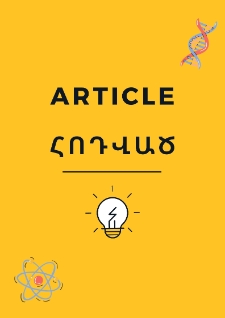Object
Title: EU-EAEU dilemma of Armenia: Does science support politics?
Co-author(s) :
Maisano D.A. ; Mirzoyan A.R. ; Manukyan A.A. ; Gzoyan E.G.
Abstract:
On January 1, 2015, the Republic of Armenia joined the (Russian-led) Eurasian Economic Union (EAEU) and actually refrained from entering into the alternative Association Agreement with the European Union (EU). Nevertheless, despite the prevalence of historic ties with the scientific community of the EAEU member-states and some push towards that direction, Armenian researchers demonstrate a certain scientific autonomy, which is expressed in numerous international scientific collaborations with researchers from many European countries. This paper proposes a bibliometric analysis of the international scientific collaboration between (i) Armenia and EU countries, and (ii) Armenia and EAEU countries, based on the papers indexed by the Web of Science Core Collection database and the Russian Science Citation Index database. Results indicate that the international collaboration with researchers from countries of both blocks gradually grows, displaying similarities and differences. Globally, Armenian researchers seem to collaborate more with researchers from EU countries rather than EAEU countries. Despite this, individual collaborations with Russia continue to prevail over those with other individual European countries, primarily Germany. Finally, it has been noted that “megaprojects” significantly influence the scientific collaborations between Armenian and foreign researchers.
Publisher:
Date submitted:
Date of publication:
Identifier:
oai:noad.sci.am:136090
DOI:
Language:
Journal or Publication Title:
Volume:
URL:
Additional Information:
Affiliation:
Institute for Informatics and Automation Problems, National Academy of Sciences of the Republic of Armenia ; Department of Management and Production Engineering (DIGEP), Politecnico di Torino, Italy
Time period:
References:
European Statistical Office (Eurostat). Retrieved July 20, 2019, from https://ec.europa.eu/eurostat/data/database. ; Finardi, U. (2015). Scientific collaboration between BRICS countries. Scientometrics,102(2), 1139–1166. https://doi.org/10.1007/s11192-014-1490-5. ; Franceschini, F., Maisano, D., & Turina, E. (2012). European research in the field of production technology and manufacturing systems: An exploratory analysis through publications and patents. The International Journal of Advanced Manufacturing Technology,62(1–4), 329–350. ; Glänzel, W., & Schubert, A. (2003). A new classification scheme of science fields and subfields designed for scientometric evaluation purposes. Scientometrics,56(3), 356–367. ; Glänzel, W., & Zhang, L. (2018). Scientometric research assessment in the developing world: A tribute to Michael J. Moravcsik from the perspective of the twenty-first century. Scientometrics,115(3), 1517–1532. ; Glukhov, V. A., Gzoyan, E. G., & Sargsyan, S. A. (2017). Assessment of scientific cooperation between the scientists from Armenia and Russia within the Joint bilateral grant projects. Sotsiologicheskieissledovaniya [Sociological Studies],7, 156–158. ; Gzoyan, E., Hovhannisyan, L., Aleksanyan, S., Ghazaryan, N., Hunanyan, S., Bourghida, A., et al. (2015). Comparative analysis of the scientific output of Armenia, Azerbaijan and Georgia. Scientometrics,102(1), 195–212. ; Melin, G., & Persson, O. (1996). Studying research collaboration using co-authorships. Scientometrics,36(3), 363–377. ; Mikhailov, O. V. (2013). Russian science citation index. The opinion of an interested user. Herald of the Russian Academy of Sciences,83(3), 292–296. ; Moskaleva, O., Pislyakov, V., Sterligov, I., Akoev, M., & Svetlana Shabanova, Sh. (2018). Russian index of science citation: Overview and review. Scientometrics,116(1), 449–462. ; Nagpaul, P. S. (2003). Exploring a pseudo-regression model of transnational cooperation in science. Scientometrics,56(3), 403–416. ; UNESCO. (2016). Science report towards 2030. ; Vinokurov, E. (2017). Eurasian economic union: Current state and preliminary results. Russian Journal of Economics,3(1), 54–70. ; Wang, L., Wang, X., & Philipsen, N. J. (2017). Network structure of scientific collaborations between China and the EU member states. Scientometrics,113(2), 765–781. https://doi.org/10.1007/s11192-017-2488-6. ; Zitt, M., Bassecoulard, E., & Okubo, Y. (2000). Shadows of the past in international cooperation: Collaboration profiles of the top five producers of science. Scientometrics,47(3), 627–657.
Indexing:
Scopus ; Social Science Citation Index
Object collections:
- Digital Library > Academic Insitutions > Insitute for Informatics and Automation Problems of NAS RA > Publications
Last modified:
Apr 23, 2021
In our library since:
Apr 15, 2021
Number of object content hits:
74
All available object's versions:
https://noad.sci.am/publication/149749
Show description in RDF format:
Show description in OAI-PMH format:
| Edition name | Date |
|---|---|
| Sargsyan S.A., EU-EAEU dilemma of Armenia: Does science support | Apr 23, 2021 |





